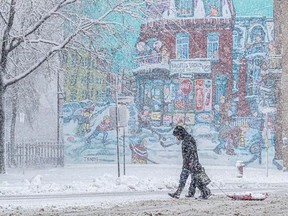Analysis of meteorological data going back to 1863 shows snowfall is one-third less today.

At the turn of the millennium, Montreal received one-third less snow in the winter compared with the 19th century, reveals an analysis of decades of meteorological data compiled by McGill University.
“We realize we’re more obsessed with snow today than we were previously, even though there was more snow in the past, because there used to be more of it,” said professor Frédéric Fabry, director of McGill’s Bieler School of Environment.
“However, flooding is equally as catastrophic.”
McGill’s meteorological observatory is the oldest in Quebec and the second-oldest in Canada. Founded in 1863, all the data registered up until 1992 was recorded by hand, often multiple times per day, in large folders that resemble large accounting books.
To take advantage of this wealth of data, the SAM (sauvetage d’archives météorologiques) project was set up in 2018, led by McGill professor Victoria Slonosky.
The goal of the project is to digitize this information to make it easier to study, analyze and share. But the work can be a colossal undertaking: it can take between 45,000 and 50,000 hours of work to transcribe the data, equivalent to a lifetime of work.
“An American colleague noted it’s like asking all attendees of a football game to work for one hour,” Fabry said.
For this reason, the project leaders decided to turn toward the citizen science model, calling upon volunteers to tackle the job. This collaboration has allowed them to re-transcribe approximately one-quarter of the manuscript data.
The first step consisted of digitizing the microfilm, which already contained all the data, so they could be made available online.
“Since people can’t come to the books, the books must go to the people,” Fabry remarked.
The images in the microfilm are somewhat irregular, he added, “and there was no way to automate the process.”
We have tried asking computers to do the work, Fabry said, “but the results have been disastrous.” The machines are incapable, at least for now, of deciphering human handwriting, or of interpreting the various shortcuts (such as symbols indicating repetition) used by humans.
Before 1975, for example, the barometric pressure was registered in inches of mercury because of the imperial system.
“A regular pressure measure is 30.234 inches of mercury,” Fabry said. “If the next measure was identical, (the person will) rewrite only 234. But if we were to enter that directly into a machine, imagine the disaster.”
The objective, he added, is to be able to compare the present with the past using the same norms.
“What has changed? What is more frequent, and what is less frequent? We’re interested in knowing the climate details of the past to shed light on the climate of the present, and how this changes and which measure of change are important,” Fabry said.
The project gained a new importance in the context of climate change, the effects of which are being felt more and more, Fabry believes.
“To understand how the climate is changing, one must know how it was before,” he said. “With detailed information, we can see, for example, if rapid accumulation (of water) over two hours like we see in thunderstorms today, did we did we see that before?”
For example, in a certain era, we recorded what is called “sliding conditions,” since travel was by horse-drawn sleigh. We were also interested in when the St. Lawrence River was frozen enough to be crossed, since Montreal was an island before the Victoria Bridge was built.
But over time, our priorities have changed, Fabry noted.
“Before electricity, freezing rain didn’t bother anyone,” he said. “But, today, society is so completely dependent on electricity that everything grinds to a halt (during a power outage).”